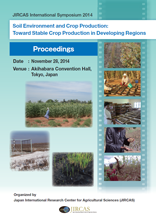Overview on Soil Fertility and Crop Production in SSA

Only a fraction of Africa’s 874 million ha is potentially suitable for agricultural production.
Arid and semi-arid lands (ASAL) comprising about a third of the potentially suitable
agricultural land are too dry for rainfed agriculture and have shortened lengths of growing
period. The continent has a wide range of soils and climatic conditions. Soils range from stony
and shallow poor soils to deeply weathered soils that recycle and support large amounts of
biomass. African soils have inherently poor soil fertility because they are very old and lack
volcanic rejuvenation. Inappropriate land use, poor management and lack of inputs have led to
a decline in productivity, soil erosion, salinization and loss of vegetation. However, general
fertility and organic matter status of soils differ from upland to lowland ecologies. Wetland
soils in the inland valley system of West and Central Africa generally are better endowed with
fertility, especially soil organic matter status than their upland relatives. They have potential
for increased agricultural intensification through an integrated use of crop genoptypes adapted
to the ecology. Supporting integrated soil fertility management with sound policy, financial
and institutional support can stimulate the much needed increase in food production.
| Date of issued | |
|---|---|
| Creator | Andre Bationo Ivan S. Adolwa |
| Publisher | Japan International Research Center for Agricultural Sciences |
| Available Online | |
| Issue | 2014 |
| spage | 46 |
| epage | 59 |
| Rights | Japan International Research Center for Agricultural Sciences |
| Language | eng |
